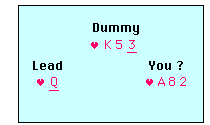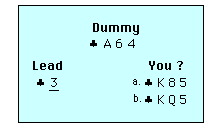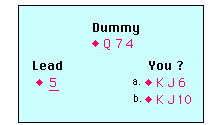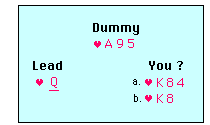All top of a . . . . . . . . . . . . . and top of . . . . . . . . . . . . . leads are a first move for a
potential . . . . . . . . . finesse against leader's left hand Opponent.
In this case if Dummy plays the King you . . . . . . . . . . . . . . . . If he plays small play your . . . . , showing Partner you . . . . . . . . . . . . |

|
|
In case a.
if Dummy plays low play your . . . . . . . . If Dummy plays the Ace, play your . . . . , showing Partner . . . . . . . . .. .
In case b. if Dummy plays low, play your . . . . . . . . . . If Dummy plays the Ace, play your . . . . . . . , to . . . . . . . . . . the suit for Partner. He may have a . . . card suit.
|

|
Rule - As Defender always play the . . . . . . card from touching Honours, except when making a . . . . . . .
Answer
(Down - Up) |
In case a. if Dummy plays the Queen, play your . . . . . . . If Dummy plays low, play your . . . . . .
In case b. if Dummy plays the Queen, play your . . . . . . . If Dummy plays low, play your . . . . . . . . .
|

|
|
In case a. if Dummy plays the Queen, play your . . . . . .
If Dummy plays low, play your . . . . . . .
In case b. if Dummy plays the Queen, play your . . . . . . . . .
If Dummy plays low, play your . . . . . . . .
|

|
Rule - When Dummy has an Honour which you as third hand can beat, only play your Honour if Dummy's . . . . . . . . is played, or if your next card is . . . . . . . . than the . . . . . . . .
Answer
(Down - Up) |
In case a. if Dummy plays low, play your . . . . . . .
If Dummy plays the Ace, play your . . . . , showing . . . . . . . . . . . . . . . . . . . .
In case b. if Dummy plays low, play your . . . . . .
If Dummy plays the Ace, . . . . . . . . . the suit by playing your . . . . . . .
|

|
When Partner leads his long suit and you hold one or two Honours but only one small card in the suit, . . . . . . your access to Partner's hand by playing your . . . . . . cards first, keeping your . . . . . card to . . . . . . . . . . . . . . . .<
Answer
|